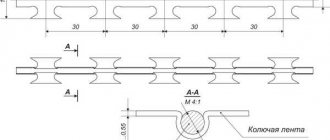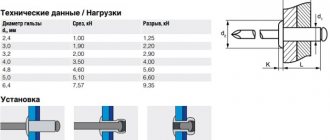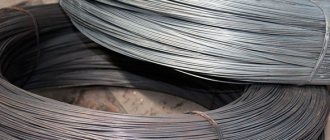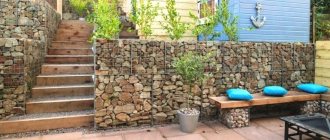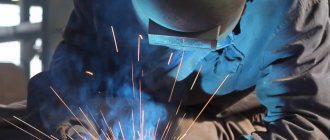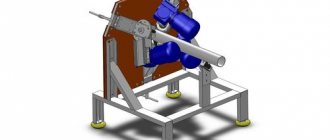Do-it-yourself installation of Egoza barbed wire is done in stages. This option has a number of advantages and disadvantages of use. Egoza prickly fabric is divided into several types. Each of them has its own distinctive features. Before proceeding with the installation of the Egoza fence, you need to select brackets for attaching the spiral. Each type is selected for a specific barbed tape.
Attaching wire fencing
What kind of fences are installed on?
“Egoza” can be installed on any structure, but, for example, wooden picket fences and other easily damaged structures are rarely supplemented with barbed wire on top. In such cases, it is often attached to the outside of the fence or laid on the ground.
Photo No. 1: Egoza on a wooden fence
From above, a safety barrier is most often installed on fences, which are easier to climb over than to break. It is especially important to mount the Egoza on a concrete fence or other permanent structure.
Photo No. 2: Egoza on a concrete fence
Note! There are a large number of ways to protect a fence made of corrugated sheets or other material using Egoza barbed wire. In the diagram below you will find the most popular installation options.
Image No. 1: methods of attaching Egoza to fences
Design options
The optimal type of fencing is chosen depending on the requirements for functionality, aesthetics and the planned budget.
- Massive self-standing reinforced concrete fences are usually used for installation around military facilities, warehouses, and industrial enterprises. Less often they are used for private housing construction. The sections have a large mass - approximately 2 tons, so they can only be installed using lifting equipment. No foundation or supports are required for their installation. The only condition is flat ground. The products are produced in two designs: for installation on reinforced concrete glasses and having a widening at the bottom.
Fences made from decorative concrete sections are an option in demand for fencing private houses, dachas, children's, educational, and medical institutions. The design includes support pillars and slabs, which can be solid or patterned. When building a span, 3 or 4 panels are usually used. As a rule, a patterned product is placed on top. The standard length of the slabs is 2.0 m, height – 0.5 m, thickness – 45 mm, average weight – 55-70 kg. The sections are attached to support posts.
- Submit a request for the manufacture of a fence.
- A representative of the company arrives, takes measurements and specifies the structure to be installed.
- A project for the future fence is made and a calculation of the consumption of materials, as well as the cost of services, is made. On their basis, an agreement is concluded.
- A team arrives with equipment and materials.
- Dismantling is carried out when the canvas is completely replaced or brackets are immediately installed.
- The spiral is laid and the support wire is tensioned.
- The coils are fixed to the support and at the places where they intersect with each other using clamps.
- The foreman delivers the completed work to the customer.
Advantages and disadvantages of installing Egoza on a fence
Installing Egoza on a fence is a great way to protect your territory from intruders. Dismantling a correctly and securely fastened “thorn” requires serious time investment.
In addition, the following advantages of installing a barrier structure on a fence are highlighted.
- Possibility to make an energized fence. This will significantly increase security.
- Reliability. "Egoza" is resistant to corrosion. The service life of the “thorn” manufactured in accordance with GOST is more than 25 years.
- Availability. Anyone can afford to buy a spiral or flat safety barrier.
- Easy to install. Installing Egoza on the fence is quick.
- A large number of installation options and application purposes. For example, for additional protection of the territory and fencing from animals and intruders, you can stretch the Egoza along the ground on one or both sides of the fence.
The disadvantages of installing Egoza include only deterioration in the appearance of the fences.
Varieties of Egoza razor tape
- AKL (reinforced razor tape) is a galvanized steel wire around which a tape with cutting blades is crimped. AKL is an improved type of “barb” of the old type: instead of pointed turns, a cutting tape stamped from sheet steel is used. Its razor-sharp edges can cause serious damage to a border violator.
- ASKL (reinforced twisted razor tape) - stamped cutting tape is twisted around rigid galvanized wire. The blades have different directions - the effectiveness and intimidating appearance of the fence increases.
- SSB (spiral safety barrier) is a three-dimensional structure made in the form of a spiral. To create it, tapes from ACL or ASCL are used. A barbed spiral fence is difficult to overcome. Even after several snacks, the SBB continues to be a serious obstacle for violators.
- PBB (flat safety barrier) is a flat design in the form of spirals, similar to SBB, only the PBB does not protrude beyond the fence and looks quite neat and not so menacing. Although this does not in any way reduce the protective functions of the fence.
Return to contents
How to properly install Egoza on a fence (useful tips)
Correctly installing the Egoza on the fence is half the battle; it is also important not to get hurt during the work. Therefore, safety precautions should be observed.
- Installation must be carried out in thick protective clothing, as you can seriously cut yourself. Particular care should be taken to protect your hands and wrists. Thick gauntlets designed for welding work are best.
- The support (stepladder or sawhorse) should be as reliable as possible. If you fall from it directly onto the wire, there is a high risk of serious injury.
- If possible, use the help of one or two partners.
- When installing a protective barrier on a metal fence, the brackets can be welded to the posts. It will be more reliable this way.
Types of barbed wire
During its existence, barbed wire was made in different ways, using the development of industrial technologies. Currently, several types of thorns are used for fencing:
- classical;
- reinforced tape;
- twisted tape.
Types of models
Classic wire is a solid thread with pieces twisted onto it. The sharp ends stick out in different directions.
Fences made from classic types are completely transparent. The thread is stretched in several rows between the pillars. They are used mainly against animals to prevent them from running away or entering someone else's territory.
Pole placement scheme
A strip of carbon steel with sharp ax-shaped protrusions is called Egoza. It has a reinforced strip of base wrapped around scraps of wire. It is characterized by high strength and sharp edges of the spikes.
Precautionary measures
Barbed wire in any version is a rather dangerous material when installed. Barbed strip and combined rolled wire with a core are especially dangerous - they not only tear, but also cut human skin. Therefore, it is necessary to work in appropriate protective clothing:
- thick fingerless mittens (so that no wire gets between them);
- thick multi-layer clothing - jacket, pants, overalls;
- wearing clear glasses to protect the eyes;
- in shoes with thick and hard soles.
Take special care when working with elastic wire - if bent, it can straighten out and whip you in the face or body.
How to make a wicker fence from branches
One of the most budget-friendly fencing options. It is very easy to make, and the materials - branches and poles - can be found literally under your feet. It has a rather aesthetic appearance, but in terms of strength and durability it cannot be compared with other solid fences. More suitable as a decorative fence next to beds, flower beds or a gazebo. However, if you wish, you can assemble a tall fence from thick poles and use it as the main fence on the site.
How to make a fence
- Stretch a cord along the fence line and mark the position of the poles (there should be an interval of about 50–60 cm between them).
- Prepare the branches. Remove the bark from the poles and burn the part that will be in the ground until charred. Soak thin rods in water to make them flexible. For the same reason, it is better to use freshly cut shoots.
- Using a crowbar, make depressions in the ground in the right places. Insert the posts into them to a depth of 30–40 cm and compact the soil so that they stick better. You can alternate thicker and thinner poles one at a time.
- Place stones along the bottom of the fence or simply start weaving 10–15 cm above the ground to protect the fence from rotting.
- Lay the rods in a checkerboard pattern, going around each pole. For uniformity, alternate branches of larger diameter with smaller ones, and alternately place the rods with a thick edge on the front and back sides of the fence.
- Press the rows of rods against each other to get a dense fence or, conversely, leave gaps for a more airy fence. Make the joints of short branches on the nearest poles. The protruding edges can later be folded inward or trimmed.
Design Features
Barbed wire is a metal thread or a narrow strip with barbs attached to it. The wire is available in several configurations. The material is used both for the construction of a full-fledged fence, and for an additional obstacle on an already installed fence of any type. The thorn is used both for fencing private houses and for protecting industrial facilities.
Initially, the design was invented to protect the territory against animals, and was often used in cattle breeding.
Later, the technology began to be used for fencing against people. The advantages of the design are its low cost, practicality and the ability to install the fence yourself.
Tools and materials
A chain-link fence can be tensioned or sectional, as shown in the photo. The first type of fence is the easiest to install. If you decide to build a wire fence with your own hands, we recommend using this installation method. To work you need to prepare the following tools:
- axe;
- shovel;
- level and plumb line;
- Bulgarian;
- metal brush;
- welding machine;
- tamper
In any case, you will need wooden poles or metal pipes. Supports made from beams are not as durable as metal ones, but are more affordable. The length of such a support should be up to 3 meters. Metal supports are the most practical. Typically, iron pipes with a diameter of 6 cm to 10 cm are used.
If you plan to use a wire fence for a long time, it is better not to save money and purchase galvanized mesh. This product will serve you for at least 20 years.
Advantages
A fence made of welded wire and its other analogues have the following positive characteristics:
- excellent light transmission;
- strength, resistance to environmental factors;
- wide choice of shapes, sizes and colors;
- good decorative indicators;
- low price of material;
- good protective performance;
- the possibility of additional connection to modern security systems, in particular the use of live wire;
- quick and easy installation;
- ease of repair.
Live barbed wire fence
Configuration
The chain-link also has different mesh configurations: square, rectangular and diamond-shaped, as shown in the photo. The size of the holes is 2.5 cm - 6 cm. The choice of mesh depends on the purpose for which it will be used.
Typically, it is used to create metal fencing in private areas. How to make a brick fence with your own hands? Today we will tell you how to make a fence from wire: we save on chain-link.
A chain link fence can be installed in two ways. This is to stretch it onto posts and make sections. The first method is quite simple, but the second will make the fence stylish.
In both cases, you can create a fence from this material with your own hands. The popularity of chain-link can be explained by its low cost and good properties.
Which wire to choose
Experienced people advise using hardened galvanized wire with sharp spikes. Stretched in two rows on the inside of the fence, it can effectively protect country property from encroachment.
It is even better to raise such wire (especially if it is spiral) higher than the fence.
The point is not only that an attacker will not be able to easily climb over it (the spiral wire springs well and is difficult to cut). Raised barbed wire has a psychological effect on the robber. Moreover, there may be areas nearby that are not protected in this way.
If you found this information useful, please subscribe to my channel.
Carrying out installation work
Before you make a wire fence, you need to decide on its type, since installation in this case will be different. If we are talking about panel wire fencing, then the following must be done:
- Pre-mark the area where the fence will be installed using a regular rope.
- Install support posts. To do this, first holes are dug about half a meter deep, into which the pillars are inserted and secured. After the supports are concreted, the sections themselves are conditioned. This is quite simple to do, since in such designs special fastening components are provided for these purposes - clamps or clips.
- Additional security elements. The metal base of the structure allows you to connect additional systems to the fence, in particular the use of an energized fence.
Advice! This design does not require the use of a foundation. However, the presence of a base will not only make the fence more durable, but will also give it a more attractive appearance, as can be seen in the photo.
Installation work is performed a little differently when it comes to barbed wire. To do this, it is also necessary to first install support pillars - they can be driven into the ground or be concreted. There are also special poles that are designed specifically for these purposes.
In any case, the distance between two supports should not be more than 2-2.5 meters.
As for how to make barbed wire, this is a rather labor-intensive process that requires a lot of time, perseverance and patience. It will be easier to buy a ready-made option, especially since it is quite inexpensive.
All posts must be firmly installed, since attaching the barbed wire to the fence will be accompanied by tension on the posts inward. Barbed wire is attached to the fence quickly enough; all work can be completed in a few hours.
Advice! Working with barbed wire is quite dangerous. Even minor wounds are very painful and take a long time to heal.
To protect yourself, you need to take care of protective gloves and thick clothing.
Lifehack
Supplying high frequency currents to the wire can cause more trouble to the owner than it is worth.
However, there is another option - to close the low-current network through a wire fence and connect it to a simple security system sensor.
When the wire is cut or bitten, the contact opens and an alarm is triggered, sending information to the owner or security post. At the same time, exposure to low current is completely safe.
Barbed wire is an indispensable option when it is necessary to fence off a large area allocated for agriculture - gardening, vegetable farming, livestock farming.
In combination with existing fences, barbed wire will greatly increase the effectiveness of preventing entry into the house.
Installation
In this day and age, the security of your home, garage or utility room is an important part of peace of mind.
Today, almost everyone can afford to install perimeter protection devices, such as video surveillance systems, various types of touch sensors, panic buttons, etc. But all these security measures are ineffective in the absence of protective barriers such as SBB.
In the production of protective barriers, the largest Russian ones (Miass), Ltd. uses only galvanized material in its production, be it a cutting profile (tape) or the basis of “Satellite Security Systems” - the core is made of spring steel wire d 2.5 mm GOST 7372-79, as well as the clamps holding this structure together made of galvanized steel 1.2 mm thick.
The staples are installed in a staggered pattern at 3 or 5 evenly spaced points around the circumference of the SBB. This is in contrast to our beloved Chinese manufacturers, who use ferrous metals in their production.
Thanks to such a serious design, SBB is highly resistant to breakage, and even if cut in several places, the SBB fence retains its original shape. The coil spring design can cause serious damage to an attacker by playing on their body like a compressed accordion.
Installing an SBB barrier presents some unique challenges. SBB barbed wire is very dangerous not only for intruders, but also for the installers themselves, so without special skills, protective clothing and tools such as installation pliers, it is simply impossible to make it.
When installing “SBB” barbed wire, it is important to pay attention to the rigidity of the barrier’s attachment to the fence, for which it is necessary to securely fasten the brackets and correctly tension the SBB onto the guide wire.
Therefore, to avoid accidents, it is better to entrust the installation of a spiral barrier to a professional installation team.
Almost everyone has seen the terrifying fences of large factories or prisons, the tops of which are covered with rings of barbed wire.
The fence should psychologically evoke fear in the intruder, and if this happens, it means that the fence has been correctly chosen and installed correctly.
From us you will buy everything you need for self-assembly:
1. Clothes for assembly (Pay special attention to gloves), preferably so-called welding gloves (suede gloves) with wrist protection.
2. Consumables Consumables : UWB barbed wire, string wire - runs inside the UWB spiral to the top and bottom points, handles, mounting clamps, mounting pliers.
Be patient and get started.
Installation instructions for SBB fencing
When installing the fence to the fence, each bracket (post) must be welded or fixed to an angle bar (the distance between the angle bars should be 2.5 - 3 m, the height above the fence should be 50 mm greater than the diameter of the FBG - 450 mm or 750 mm , the shape and method of attaching the corner bar to the fence are arbitrary, depending on the design of the fence).
The SBB is stretched to its working position and secured to the brackets using 2mm diameter steel wire twisted at two points. When assembling the next coil, the outermost turn of the first coil is connected to the outermost turn of the second coil using steel wire with a diameter of 2 mm, twisted at two diametrically opposite points.
Other options for installing fencing are possible at the customer's discretion.
Image of SBW barbed wire installation options.
© 2006-2021, Atlant Media LLC. All rights to photographs, graphic elements, text information belong to the owner of the site, Atlant Media LLC.
Site Map
Photo #6: Spiral Safety Barrier (SSB)
Cable routing
There are 2 ways to install this type of fencing:
- Forming pieces of wire with pointed parts between the posts;
- Attaching a wire structure over the fence.
The choice is made depending on the purpose of the object. For example, in areas of particular concern, a second option is to provide a canopy fence made from studded tape, in which case the protection is often enhanced by electrical current passing through the metal parts of the structure. Wire fencing also provides security and is a quick option to install.
Types of fastenings
There are several types of fasteners, differing in configuration, which allows you to fasten metal strips with different characteristics and shapes. The main options are:
- Straight. Such products are secured with 1 or several rows of barbed wire. The function of straight brackets is the same as the top of the posts, which are raised more above the fence than is typical. For this reason, they are interchangeable, but the fence looks better with special elements.
- L-shaped. One bracket bar is attached to the posts, sections of the fence, and the other is moved to the side, not always at a right angle. This option increases the reliability of the entire structure, since it is impossible to jump over or climb over the fence due to the strip of the bracket expanding to the sides, on which the wire is attached.
- U- and Y-shaped, rounded. Suitable for attaching spiral cutting strips.
If uncoated products are used, they can be attached to metal posts by welding. This option is possible in case of self-construction. In most cases, buckles coated with polymer powder are used. Such products are fastened with self-tapping screws and are not suitable for welding due to the protective layer.
Installing a spiral safety barrier on a fence
This method is considered the simplest. The result is a reliable and inexpensive fence. You need to prepare:
- wire (tape with cutting edge);
- brackets;
- screws or welding machine;
- metal staples;
- pliers;
- rope.
The choice of method for attaching the brackets depends on the type of material from which the poles are made. If they are protected with a polymer powder coating, self-tapping screws are used; If there are no holes provided for this, you can make your own. The metal strip is attached to the brackets using staples. To prevent it from sagging, a rope is pulled over it. This should go through the wire rings on the fence. A distance of at least 50 cm from the top of the fence is sufficient.
Ground installation steps
Select the material with the largest diameter. It is recommended to build a fence consisting of 2-3 rows of reinforced tape with rods. The frame - metal posts and beams - is used to attach the tape with the cutting edge. They are installed in the same way as any other type of fencing: they are buried in the ground, concreted, and cross beams are welded.
Beams with a cutting edge are provided for each row of tape. The section is filled gradually as a wire is secured over each cross beam. The brackets are installed on the top of the fence. It is recommended to use U- or Y-shaped pieces for this purpose, which will best hold the top row of tape with sharp edges. A fishing line is also stretched between the rows (between the beams), it is important that its cutting edge enters the center of the tape rings. This will prevent the structure from collapsing.
Installation of a continuous fence with spikes
In this case, a mesh with spikes is used. It consists of wire with blades and is produced as a prefabricated product. The mesh must be secured between the posts. The principle of their installation is standard: they are installed at a distance of 2.5-3 m and buried in the ground to a depth of 0.8-1.5 m (depending on the degree of soil freezing).
The mesh is attached between the racks using special elements - meshes. You can place an individual order for such posts. Each element contains up to 20 lugs, which are welded to metal posts at a distance of 10-20 cm. You can easily weld them yourself. The mesh will be attached to the holders with metal brackets; do not use fishing line. If the barbed wire is too tight, it will not sag. To be on the safe side, the fishing line can be placed on top of the fence along the edge of the fabric.
V-shaped bracket arrangement
How to protect yourself
If a summer resident assumes that only barbed wire can protect his property from illegal entry and damage, he can place it along the fence, but it is better if it is placed on the inner perimeter of the plot.
If a bystander injures himself on the outside of the thorns, the case may end up in a personal injury case and go to court.
The imagination of the owners of summer cottages can be limitless. Someone will not limit himself to stringing the barbed wire and will decide to pass a current through it, rightly believing that there cannot be excessive vigilance. This is mistake.
In the event that a person encroaching on the property of a summer resident suffers serious health damage, it will be difficult for the owner of the site to avoid responsibility.
The Criminal Code has enough articles, from causing bodily harm to causing death by negligence. And warning signs posted around the perimeter of the site will not serve as a mitigating circumstance.
Barbed wire fence: areas of its use
This type of fence can be installed on objects for various purposes:
- private housing (houses, cottages);
- construction sites;
- military or industrial facilities;
- warehouses;
- car parking;
- dog walking areas;
- any objects that need monitoring, barbed wire on the fence is installed in addition to the tracking systems;
- pastures and protected areas;
- barriers to protect animals in the forest belt through which highways pass;
- special purpose zones (prisons, secret facilities, ammunition depots).
